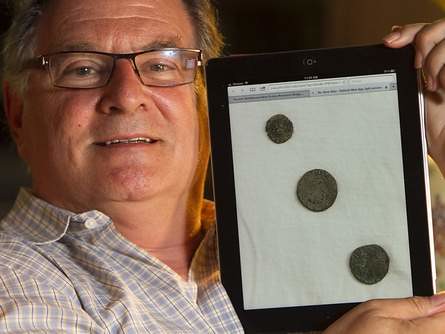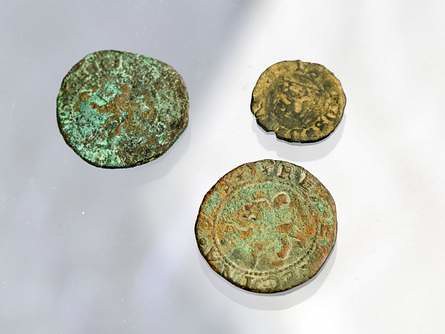
PREV ARTICLE
NEXT ARTICLE
FULL ISSUE
PREV FULL ISSUE
COINS FOUND AT SITE OF DE SOTO'S 1539 FLORIDA ENCAMPMENT
Alan Stahl of Princeton University consulted with archaeologists who found coins at a site of in Florida believed to be the location of a 1539 encampment of the Spanish explorer De Soto. Here are excerpts from a couple newspaper articles. An exciting find!
-Editor
Archaeologist Ashley White is following historical bread crumbs left behind nearly 500 years ago. The trail leads to a site where, in the summer of 1539, Spanish explorer Hernando De Soto and hundreds of his men camped midway between present-day Ocala and Gainesville, archaeologists now believe. The process of authenticating a historically significant find can be as time-consuming and painstaking as unearthing and cleaning the brittle artifacts buried in the earth. In this case, it required the help of other archaeologists, historians and experts on Spanish culture in identifying and dating artifacts from the De Soto encampment and a nearby Spanish mission that was founded more than 60 years after De Soto. The artifacts include coins minted before De Soto's expedition, multi-layered glass beads crafted in Italy during the early 16th century, bits of chain mail armor used by the Spaniard's men to try to protect themselves against Indians, and a mandible and teeth from a pig bred in Spain during the time De Soto set sail for the New World.

Dr. Stahl with images of the coins on his iPad For Alan Stahl, curator of numismatics at Princeton University, coins found at archaeological sites are as good as calendars, and three of the many coins White found point to De Soto. They were minted far earlier than coins associated with the Spanish mission period and were found some distance from the mission site, along with other De Soto-era artifacts. “It was pretty clear what was what,” Stahl said. “Coins are the one aspect of the government of the state that every individual would have come in contact with. Very few people would have met the king, but most people, even in the Middle Ages, had coins with the king's name and image.” Stahl said coins during De Soto's time stayed in circulation far longer than modern coins. Most rulers didn't mint new copper coins for decades because it cost more to make them than they were worth. Stahl said he would expect copper coins, rather than gold or silver, to be found at an archaeological site. “If you had a gold coin and you dropped it, chances are you would pick it up. You would go back and dig it up even if you dropped it in a latrine,” Stahl said. Copper coins blended with the color of soil and weren't as easily found, or worth looking for. Stahl said coins were hauled along in expeditions because soldiers and workmen had to be paid. Jerald Milanich is a De Soto expert, curator emeritus in archaeology of the Florida Museum of Natural History and author of books about De Soto and the Florida Indians. For Indians, the currency was glass, not coins, and some of the beads White found matched those De Soto would have given to Indians, Milanich said. To read the complete article, see: Verifying a local archaeologist's De Soto discovery (www.gainesville.com/article/20120708/ARTICLES/120709675)
Here's a separate sidebar article and image of the coins.
-Editor

Three copper coins have been registered in the Florida archives. Two bear the likeness of Ferdinand and Isabella. The mint is uncertain but was likely between 1497 and 1504. They were cuarto de 4 maravedi, a small denomination that could be used to buy two eggs or a loaf of bread. The other coin bears the likeness of Enrique IV and can be dated to between 1454 and 1474. It also is a small-denomination coin.
To read the complete article, see:
Artifacts: The De Soto site
(www.gainesville.com/article/20120707/ARTICLES/120709697)
The Numismatic Bibliomania Society is a non-profit organization promoting numismatic literature. See our web site at coinbooks.org. To submit items for publication in The E-Sylum, write to the Editor at this address: whomren@gmail.com To subscribe go to: https://my.binhost.com/lists/listinfo/esylum All Rights Reserved. NBS Home Page Contact the NBS webmaster 
|